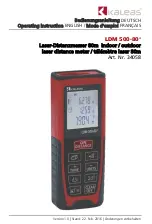
Ten standard centre frequencies are used 31.5Hz, 63Hz, 125Hz,
250Hz, 500Hz, 1kHz, 2kHz, 4kHz, 8kHz and 16kHz. These allow the
engineer to gain a clearer ‘picture’ of the frequency distribution of the
noise. Typical responses of these filters are shown below (Figure 2).
A memory facility is provided to allow the user to switch the filters
‘in’ and ‘out’ and still remain on the same frequency.
Figure 2 – Filter Responses
The filter’s AUTO mode facility allows a chart recorder to give an
octave band plot for a ‘hard’ copy of the noise spectrum. The fre-
quency control buttons are assigned different ‘roles’ in this mode,
labelled RESET and START-STOP.
Depressing the RESET button at any time causes the filter frequency
to reset to the lowest centre frequency, 31.5Hz. By depressing the
START-STOP button once, the filter will step up through all the fre-
quencies in turn, staying on each frequency for 3 to 4 seconds. This
allows enough time for the meter circuitry and chart recorder to settle.
Immediately after depressing the START-STOP button, and between
each change of frequency, a short downward stroke is drawn onto the
chart recorder to enable each octave band sound level to be separated
and therefore clearly seen.
9
Содержание GA112
Страница 1: ......










































